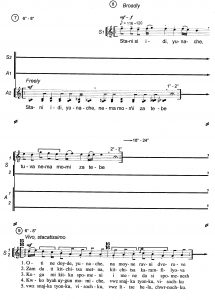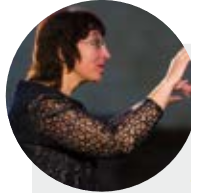Irregular Meters in South-eastern European Folk Music
By Theodora Pavlovitch, conductor and Professor
South-eastern Europe is a very special region of the Old Continent. Situated at the crossroads between Europe and Asia, it is a cradle of civilizations and has always been one of the most colourful regions of the world. Multicultural exchanges between the ethnic groups, nations and countries in this area have been a perpetual process from Ancient Times until today, and particularly in the field of music, where you can find plenty of phenomenon that are the same or similar.
One of the most prominent examples of the mixture and mutual influence of music traditions is music written by John Koukouzel, also known as Joahnis Koukouzeles (1280 – 1360?) – the most famous Medieval composer, reformer and singer of the region. Born in Durras (Durazzo) in the Eastern Roman Empire, nowadays Albania, to a Bulgarian mother and an unknown father (most probably Albanian), Koukouzel was educated in Constantinople in the best traditions of Byzantine music. It is almost impossible to define his nationality and background; the Bulgarians insist he was Bulgarian because of his mother, the Albanians insist he was Albanian because he was born there, the Greek insist he was Greek because he grew up there and was educated in Constantinople… -an endless discussion!
Another example of strong music influences in the region is Adela Peeva’s 2003 documentary named “Whose is that song?”. She starts the story by saying: “I was in Istanbul with friends from Balkan countries – a Greek, a Macedonian, a Turk, a Serb and me – Bulgarian. There I heard the song I want to tell you about. Immediately after having heard the song, we all started singing in our own languages and everyone insisted it was a song from their country. And so, the discussion started – whose is that song?”. Subsequently she filmed interviews with her camera in all the countries in the region and everyone interviewed was certain that the song belonged to his/her nation. Different texts, different contents and different meaning but with the same melody – that song existed everywhere! This documentary won a dozen of awards from international festivals in different countries in Europe, the USA and Asia.

In folk music traditions, we face the same situation concerning the melodies, the ornaments and mostly the rhythms and meters. Encyclopaedia Britannica describes meters as: “Metre, also spelled Meter, in music, rhythmic pattern constituted by the grouping of basic temporal units, called beats, into regular measures, or bars; in Western notation, each measure is set off from those adjoining it by bar lines. A time (or metre) signature, found at the beginning of a piece of music, indicates the number of beats in a measure and the value of the basic beat. For example, 3/4 metre has three quarter-note beats per measure. The time signature implies that an accent regularly occurs on the first beat of each measure. Simple metres are duple (e.g., 2/2, 2/4), triple (3/4, 3/8), or quadruple (4/4, 4/8). Compound metres are also duple (6/8, 6/16), triple (9/8), or quadruple (12/8) but have time signatures that indicate the number of beats to be a multiple of three. Thus, in 6/8, for example, both beats of the basic duple division are divisible into three subunits, yielding a total of six. Some metres that occur less frequently are neither duple nor triple (5/4, 7/4) but may be considered a combination of duple and triple—such as 2/4+3/4 or 3/4+2/4+2/4.” (https://www.britannica.com/art/metre-music)
We can find a definition of irregular meters in a different source. “Irregular meters (also called asymmetrical meters) establish a regular metric pattern from an asymmetrical sequence of two or more-time signatures. A 5/8-time signature, for example, is usually understood as the sum of two simple meters 3/8 + 2/8 or 2/8 + 3/8. Beat hierarchy in irregular meters, just like in regular meters, is either simple (diving in two equal parts) or compound (diving in three equal parts). The time signature of 15/16, however, corresponds to the compound meter relative of 5/8. Compound meters include only those time signatures whose numerator is a multiple of three.
Used frequently by different folk traditions across the globe, the use of asymmetrical meters is often associated as a stylistic trait of Balkan music, in Southeast Europe. In classical music asymmetrical meters are used sporadically before the twentieth century. The second movement of Tchaikovsky’s Sixth Symphony (1891-93) is commonly referenced as one of the first examples of orchestral music written entirely in an asymmetrical meter (5/4). Irregular meter can be seen represented in different ways. Hungarian composer Bela Bartok (1841-1945), for instance, wrote Six Dances in Bulgarian Rhythm using time signatures, exposing the respective addends, such as, 4+2+3/8, 2+2+3/8, 3+2+3/8 (also called a 4/4 unevenly grouped), 2+2+2+3/8” (http://www.thesoundstew.com/2010/04/irregular-meters-irregular-meters.html)
In scientific literature, you can find the terms: irregular meter, time signatures or additive rhythm, divisive rhythms, uneven beats, asymmetric measures, irregular times – they all concern the same specific phenomenon.
The irregular meters spread in South-eastern Europe are:
5/8 and 5/16: existing in Bulgaria, Romania and Serbia
7/8 and 7/16: in Bulgaria, Macedonia and Greece;
8/8 and 8/16: in Bulgaria and Croatia;
9/8 and 9/16: in Bulgaria and Serbia;
10/8 and 10/16: in Bulgaria;
11/8 and 11/16: in Bulgaria, Serbia and Macedonia;
12/8 and 12/16: in Bulgaria;
13/8 and 13/16: in Bulgaria;
15/8 and 15/16: in Bulgaria;
17/8 and 17/16: in Bulgaria.
 All these meters exist in different combinations of the metric groups and they are usually combined with corresponding dances. Therefore, most of the meters have been named upon the dances called “horo” in Bulgaria, “kolo” in Serbia and Croatia, “χορός” (horos) in Greece, and “oro” in Macedonia – collective dances deeply grounded on the meters specific for the region.
All these meters exist in different combinations of the metric groups and they are usually combined with corresponding dances. Therefore, most of the meters have been named upon the dances called “horo” in Bulgaria, “kolo” in Serbia and Croatia, “χορός” (horos) in Greece, and “oro” in Macedonia – collective dances deeply grounded on the meters specific for the region.
For instance, the meters 7/8 and 7/16 exist in several combinations of metric groups as follows:
2+2+3: called Rachenitsa, one of the most popular Bulgarian meters and dances;
3+2+2: mostly in Macedonian regions in Greece, Northern Macedonia and Bulgaria (clear influence between the traditions of ethnic groups that were spread throughout different countries due to many historical events).
2+3+2: uncommonly used in Bulgaria.
Some other examples of different combinations are as follows:
5/8 (2+3) or (3+2)
8/8 (3+2+3) or (2+3+3)
9/8 (2+2+2+3), (2+2+3+2),(2+3+2+2), (3+2+2+2)
10/8 (3+2+2+3),(2+2+3+3)
 11/8 (2+2+3+2+2), (2+2+2+2+3) , (3+2+2+2+2) – called Kopanitsa.
11/8 (2+2+3+2+2), (2+2+2+2+3) , (3+2+2+2+2) – called Kopanitsa.
12/8 (3+2+2+2+3), (3+2+2+3+2), (2+3+2+2+3) – called Petrunino horo.
13/8 (2+2+2+2+2+3)
14/8 (2+3+2+2+3), (2+2+3+2+3)
15/8 (2+2+2+2+3+2+2), (2+2+2+2+2+2+3)
(15/16 is called Buchimish and exists in the Thracian region in South Bulgaria) – https://www.youtube.com/watch?v=xeGgdjY5oXI
)
Heterometric:
17/8 (2+2+2+2+2+2+2+3) or 17/16 ( Horse-step horo)
18/8 (3+2+2+2+2+3+2+2) or 18/16 (Yovino horo)
22/8 (2+2+2+3+2+2+2+3+2+2) or 22/16 (Sandansko horo)
25/16 (3+2+2+3+2+2+2+2+3+2+2) or can be counted as 7+7+11/16 (Sitting
Donka horo)
This variety and richness of irregular meters is one of the most valuable cultural aspects of the heritage of South-eastern European countries. Nobody can determine when exactly all those songs and dances were created. At the end of the 14th century, the Turkish armies attacked South-east Europe and it was soon completely taken over by the Ottoman Empire. Terrible damage was caused to national cultures in the 500 years that followed. One of the most important factors that preserved national spirit over the ages of domination was music – rich folk traditions and the old orthodox chants sang in monasteries and nunneries. Unfortunately, as a result of the frequent robberies and fires, most of the rich cultural heritage hidden in them was destroyed. But because of the specific historical conditions, the influence between orthodox and folk songs was very intensive and a great number of anonymous orthodox chants with folk elements can be found in the liturgy even today.
damage was caused to national cultures in the 500 years that followed. One of the most important factors that preserved national spirit over the ages of domination was music – rich folk traditions and the old orthodox chants sang in monasteries and nunneries. Unfortunately, as a result of the frequent robberies and fires, most of the rich cultural heritage hidden in them was destroyed. But because of the specific historical conditions, the influence between orthodox and folk songs was very intensive and a great number of anonymous orthodox chants with folk elements can be found in the liturgy even today.
Until the second half of the XIX Century, all music was composed anonymously by unknown, talented people without any music education. Around the middle of the XIX Century, some people started going to different countries and studying music and this was the beginning of the professional music life in the countries of the region. Dozens of people from Bulgaria, Serbia, Greece, etc. travelled to get a high level of music education in Milan, Munich, Prague, Moscow, St. Petersburg and at the National University of Music in Bucharest (established in 1863).
The first generations of composers from South–eastern European countries, parallel with creating new compositions with a European style, maintained and developed music traditions by using many irregular meters in their works. They became the first professional composers and conductors in the region and started building the national composing styles in their own countries. New compositions or arrangements of existing folk songs had been a trend in their creativity and most of their pieces are still regularly performed to this day.
Irregular meters and other folk elements have also been intensively used by the next generations of composers who built a higher level of choral music and even in their symphonic pieces. This tendency still exists today, proving the power of creative energy preserved in folk traditions and irregular meters – one of the most spectacular and vivid music phenomenon in the world’s music.
 Theodora Pavlovitch is a Professor of choral conducting and is Head of the Conducting Department at the Bulgarian National Academy of Music. She is also a conductor of the Vassil Arnaoudov Sofia Chamber Choir and the Classic FM Radio Choir (Bulgaria). In 2007/2008 she conducted the World Youth Choir and was honoured by UNESCO with the title Artist for Peace, recognizing the WYC’s success as a platform for intercultural dialogue through music. Prof. Theodora Pavlovitch is frequently invited as a member of Jury panels to a number of international choral competitions, as conductor and lecturer to prestigious international events in 25 European countries, USA, Japan, Russia, China, Hong Kong, Taiwan, South Korea, Israel. Since 2012, T. Pavlovitch has been a representative for Bulgaria in the World Choral Council. Email: theodora@techno-link.com
Theodora Pavlovitch is a Professor of choral conducting and is Head of the Conducting Department at the Bulgarian National Academy of Music. She is also a conductor of the Vassil Arnaoudov Sofia Chamber Choir and the Classic FM Radio Choir (Bulgaria). In 2007/2008 she conducted the World Youth Choir and was honoured by UNESCO with the title Artist for Peace, recognizing the WYC’s success as a platform for intercultural dialogue through music. Prof. Theodora Pavlovitch is frequently invited as a member of Jury panels to a number of international choral competitions, as conductor and lecturer to prestigious international events in 25 European countries, USA, Japan, Russia, China, Hong Kong, Taiwan, South Korea, Israel. Since 2012, T. Pavlovitch has been a representative for Bulgaria in the World Choral Council. Email: theodora@techno-link.com
Edited by Charlotte Sullivan, UK

